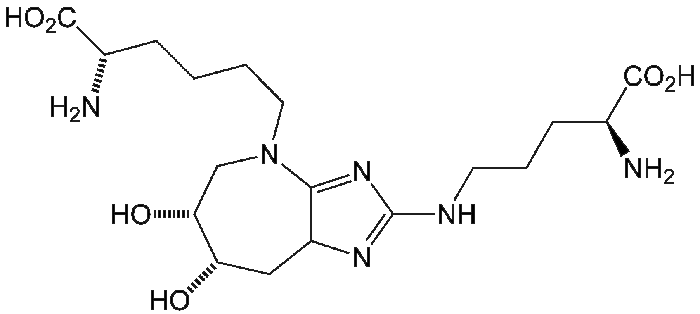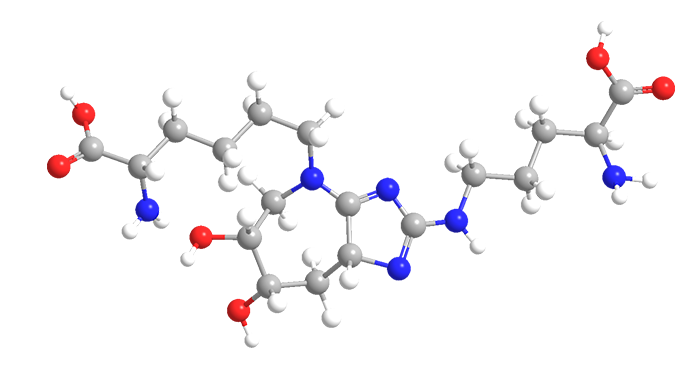What molecule am I?


In biological systems, some proteins react with open-chain carbohydrates to form adducts that contain amino acid and carbohydrate residues. When the carbohydrate is d-glucose, the product is glucosepane, which has lysine and arginine components.
Glucosepane belongs to a group of substances known as advanced glycation end products, or AGEs. It is by far the most common AGE in human tissue. Glucosepane irreversibly forms cross-links in the collagen of the extracellular matrix (ECM).
As people age, the level of glucosepane in the ECM increases, which can lead to joint stiffening and arteriosclerosis. This effect is accentuated in diabetes patients. Scientific studies on glucosepane’s effects are hampered by the existence of eight optical isomers (diastereomers) in the natural substance. The structure of one of the eight is shown here.
David A. Spiegel and co-workers at Yale University have devised a convenient way to selectively synthesize all eight diastereomers. A key step is a procedure for making the central 4H-imidazole ring. The researchers believe that their method will be useful in other synthetic applications.
MOTW Update
The pesticide pyriproxyfen was the October 3, 2011, Molecule of the Week. Lately, it has emerged in the news about the Zika virus. An Argentinian physicians group claims that pyriproxyfen, which is used to kill insect larvae in drinking water, and not the Zika virus, is responsible for the outbreak of microcephaly in infants. The physicians blame the epidemic on aggressive marketing by the pyriproxyfen manufacturer Sumitomo Chemical and the government’s indifference to the consequences.
The Brazil Ministry of Health counters by saying, “No epidemiological studies show the association between use of pyriproxyfen and microcephaly.” The ministry supports its argument with medical evidence that microcephaly is related to Zika and with the observation that the condition exists in places where the pesticide is not used.

Learn more about this molecule from CAS, the most authoritative and comprehensive source for chemical information.
Molecule of the Week needs your suggestions!
If your favorite molecule is not in our archive, please send us a message. The molecule can be notable for its current or historical importance or for any quirky reason. Thank you!
Stay Ahead of the Chemistry Curve
Learn how ACS can help you stay ahead in the world of chemistry.

